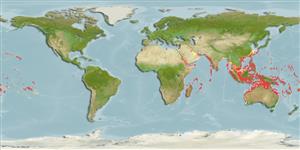>
Mulliformes (Goatfishes) >
Mullidae (Goatfishes)
Etymology: Mulloidichthys: Latin, mullus = soft + Greek, ichthys = fish (Ref. 45335).
More on author: Lacepède.
Issue
The subspecies Mulloidichthys flaviolineatus flavicaudus Fernandez-Silva & Randall, 2016 remains in the synonymy of Mulloidichthys flavolineatus; the two subspecies can be at best understood as two well-differentiated populations, in Uiblein et al., 2020 (Ref. 123209:148).
Environment: milieu / climate zone / depth range / distribution range
Ecologie
marien rifbewoner; diepte 1 - 99 m (Ref. 123209). Tropical; 30°N - 37°S, 22°E - 124°W
Indo-Pacific: Red Sea, East and South Africa, Madagascar and Mascarenes to the Hawaiian Is., Line Is. and Pitcairn Group; north to southern Japan and Midway Is.; south to Australia (North West Cape, WA, Eastern Australia, NSW) at 36°S, Lord Howe I. and New Caledonia; one record from New Zealand. Common throughout most of its range (Ref. 9710).
Lengte bij maturiteit / Grootte / Gewicht / Leeftijd
Maturity: Lm 20.8, range 12 - ? cm
Max length : 43.0 cm TL mannelijk / geslacht onbekend; (Ref. 9710); common length : 25.0 cm TL mannelijk / geslacht onbekend; (Ref. 30573); max. gepubliceerd gewicht: 423.30 g (Ref. 121845)
Dorsale stekels (totaal) : 8; Dorsale zachte stralen (totaal) : 9; Anale stekels: 1; Anale zachte stralen: 7. Back grey to olive, sides and belly whitish; 1-2 longitudinal yellow bands; dark blotch below 1st dorsal fin (Ref. 5405). Yellow-mid-lateral stripe from eye to tail and some yellow striping on cheek and along abdomen (Ref. 48636). Head length 3.1-3.5 in SL, length of snout 1.9.-2.2 and barbel 1.4-1.7 in HL. Body depth 3.7-4.8 in SL. (Ref. 90102)
Occasionally schooling species inhabit shallow sandy areas of lagoon and seaward reefs (Ref. 9710). Large adults are often found solitary on sand slopes with other species following to feed on prey that are disturbed when the goatfish is feeding (Ref. 48636). Benthopelagic (Ref. 58302). Feed on crustaceans, mollusks, worms, heart urchins and foraminiferans. Consumed fresh or dried. Minimum depth reported taken from Ref. 30874.
Myers, R.F., 1991. Micronesian reef fishes. Second Ed. Coral Graphics, Barrigada, Guam. 298 p. (Ref. 1602)
Status op de Rode Lijst van het IUCN (Ref. 130435)
Gevaar voor de mens
Reports of ciguatera poisoning (Ref. 130160)
Gebruik door de mens
Visserij: commercieel; sportvis: ja; Aquarium: Commercieel; aas: usually
Tools
Speciale rapporten
Download XML
Internetbronnen
Estimates based on models
Preferred temperature (Ref.
123201): 24.5 - 29, mean 27.8 °C (based on 1256 cells).
Fylogenetische diversiteitsindex (Ref.
82804): PD
50 = 0.5078 [Uniqueness, from 0.5 = low to 2.0 = high].
Bayesian length-weight: a=0.01072 (0.00936 - 0.01227), b=3.09 (3.05 - 3.13), in cm total length, based on LWR estimates for this species (Ref.
93245).
Trofisch niveau (Ref.
69278): 3.8 ±0.3 se; based on diet studies.
Weerstandsvermogen (Ref.
120179): Gemiddeld, minimale populatieverdubbelingstijd 1,4-4,4 jaar (K=0.16-0.27).
Prior r = 0.57, 95% CL = 0.37 - 0.85, Based on 2 data-limited stock assessments.
Fishing Vulnerability (Ref.
59153): Moderate vulnerability (39 of 100).
Climate Vulnerability (Ref.
125649): Moderate to high vulnerability (46 of 100).
Nutrients (Ref.
124155): Calcium = 41.7 [22.8, 67.6] mg/100g; Iron = 0.474 [0.224, 0.798] mg/100g; Protein = 18.8 [17.0, 20.5] %; Omega3 = 0.159 [0.108, 0.280] g/100g; Selenium = 34.4 [21.0, 57.4] μg/100g; VitaminA = 91.6 [32.7, 311.0] μg/100g; Zinc = 1.01 [0.64, 1.39] mg/100g (wet weight);
